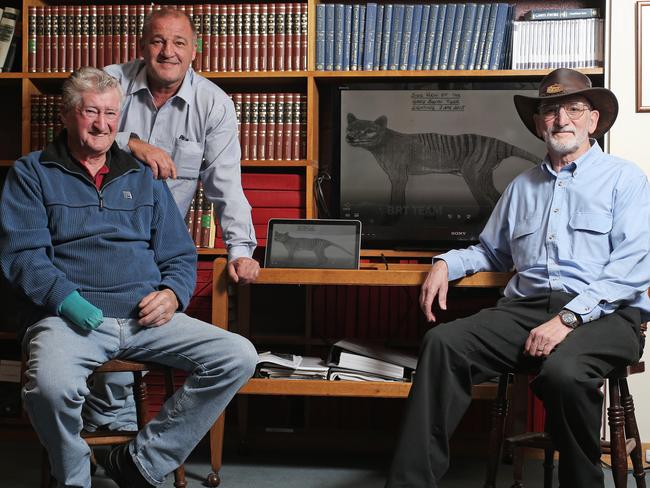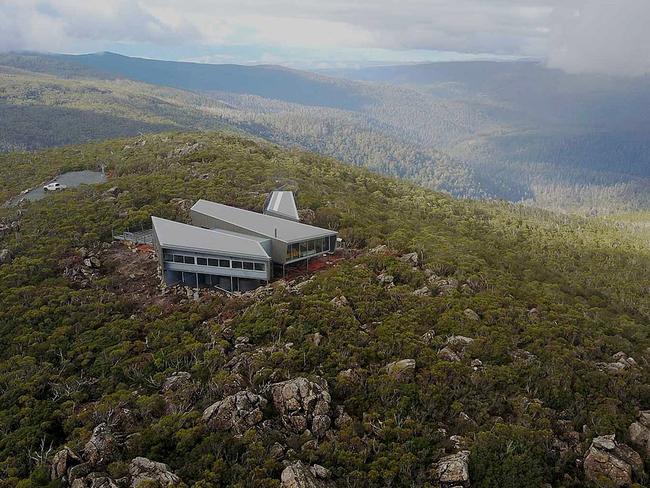New footage fuels long futile hunt for Tasmanian tiger
UPDATED: A TEAM of Tasmanian thylacine trackers has released footage of what they believe is proof a population of thylacines continues to live in the island state. WATCH THE VIDEO
Tasmania
Don't miss out on the headlines from Tasmania. Followed categories will be added to My News.
A TEAM of Tasmanian thylacine trackers has released footage of what they believe is proof a population of thylacines continues to live in the island state.
The series of images and videos, taken at a secret location in southern Tasmania, are being touted as the most reliable evidence that Tasmanian tigers still exist.
An expert in Tasmanian wildlife has assessed the videos, and rated the possibility that thylacines still exist as “perhaps a one in three chance”.
MORE: The day I stared down a thylacine
The thylacine enthusiasts who released the grainy and fleeting footage say it shows a thylacine walking slowly at a distance, a thylacine nose at the camera lens, and a thylacine with a cub.
Though the precise location is being kept under wraps, the images were taken in bushland about 50km from the former forestry outpost Maydena.

The man who took the images in November last year, Greg Booth, said he also had a face-to-face encounter with a Tasmanian tiger in 2015.
Mr Booth said he did not believe in rumours about the continued existence of the thylacine until his personal encounter while bushwalking with his dad George “Joe” Booth on an old convict trail.
“I didn’t believe in him [the thylacine],” said Mr Booth, a wood carter from Ouse in the Central Highlands.
“But when it’s in front of you … now I have no doubt at all,” he said.
He and his dad set trail cameras after the encounter and discovered the November 4 footage when they were viewing their camera SD cards in late November.
Mr Booth said the new footage was the best evidence to date of the continued existence of the thylacines, because of the animal’s distinctive stripes, long tail and size.
For verification, they gave the footage to Adrian “Richo” Richardson, who has been researching thylacines for 26 years.
“I don’t think it’s a thylacine ... I know it’s a thylacine,’ Mr Richardson said.
“The thylacine exists and I want nothing more than for the species to survive and its welfare looked after,” he said.
Joe Booth, 80, said he had always believed thylacines were in the area because he had heard their distinctive high-pitched barks.
He said he also saw a thylacine near his property in Ellendale, in the Derwent Valley, in the 1950s.
Mr Booth, a former forestry worker, said there were a number of people in the industry who still spotted thylacines but were too scared to come forward.
“The thylacine has always existed and always will,” he said.
Mr Booth said the recent sighting was in a forestry area, but he was not concerned the activity would threaten the population.
“They have already survived 80 years of logging,” he said.

The three men have joined forces, calling themselves the Booth Richardson Tiger Team (BRT Team).
They are continuing to set trail cameras in a corridor of bush where they believe the population of thylacines exists.
They said they had nothing to gain by releasing the images, but believed they were important for science.
They have passed copies to the Tasmanian Government for further assessment.
Today’s press conference was held a Hobart legal firm, which has been holding the footage.
The men said they handed the video to lawyers in December for safekeeping and to prove they had not tampered with it.
In the months since, they have been trying to gather scientific verification from experts.
Wildlife biologist Nick Mooney, who has spent decades investigating tiger sightings, has analysed the images and visited the sight of the supposed sighting.

In a report about the recent BRT Team images, Mr Mooney writes that the collection contains one key image that has a “one in three” chance of being a thylacine.
The image shows an animal about 10-11m from the camera, which turns away from the camera and is in view for about 1.8 seconds.
“Assuming the footage is authentic, the animal is either a very large spotted-tailed quoll (they do grow to more than 7kg) or a small thylacine,” Mr Mooney writes.
Mr Mooney’s report analyses the animal’s size, movement, behaviour, colour, shape and proportions.
“I am happy to suggest that based on this limited analysis of the film, there is perhaps a one in three chance the image is of a thylacine,” he says.
The footage was analysed by three experts in Tasmanian wildlife.
Mr Mooney writes that the two others could see some resemblance.
“Both observers rated the likelihood of the image being a thylacine as 30-40 per cent based on movement, behaviour and a crude expression of size.”
Mr Mooney, who has retired from the Department of Primary Industries, Parks, Water and Environment, is still called upon for expert opinion on occasional thylacine “sightings”, possible droppings and footprints.
But, to date, there has been no verifiable evidence of the continued existence of thylacines.

Official accounts suggest the thylacine became extinct on the Australian mainland more than 2000 years ago, although unverified “sightings” occur across many states of Australia from time to time.
The new video comes on the anniversary of the death of the last known thylacine at the Beaumaris Zoo in Hobart on September 7, 1936.
That last captive thylacine, known as Benjamin, was trapped in the Florentine Valley, west of Hobart, in 1933.
A video of Benjamin pacing around a zoo cage, where he spent his final three years, is the last definite footage of a Tasmanian tiger.
Although a thylacine population survived in Tasmania long after the demise of their mainland cousins, a bounty was placed on their heads in the 19th century because they were believed to be responsible for sheep deaths.
The population went into rapid decline and the Tasmanian Government introduced official protection for the species in 1936, just two months before the last known thylacine died in captivity.
Searches for the thylacine have continued ever since, with some enthusiasts adamant they have seen living tigers in recent decades.
Tasmanian thylacine expert Col Bailey, who has dedicated most of his life to searching for the mysterious animal, last saw what he believes was a thylacine in 1995.
Mr Bailey is certain thylacines continue to exist in Tasmania.
MORE: TIGER SIGHTINGS IN QUEENSLAND SPARKS NEW SEARCH
The only academic search for thylacines currently underway in Australia is in Queensland.
Historic reports of thylacine sightings have flooded James Cook University in recent months after researchers announced plans, earlier this year, for a field survey in the wet tropics to hunt the marsupial. The researchers plan to place 50-100 trail cameras in secret locations in the far north from October.
Meanwhile, South Australia’s water authority has geared up with new DNA sampling technology to test conclusively whether that state’s recent thylacine sightings are based on fact.


